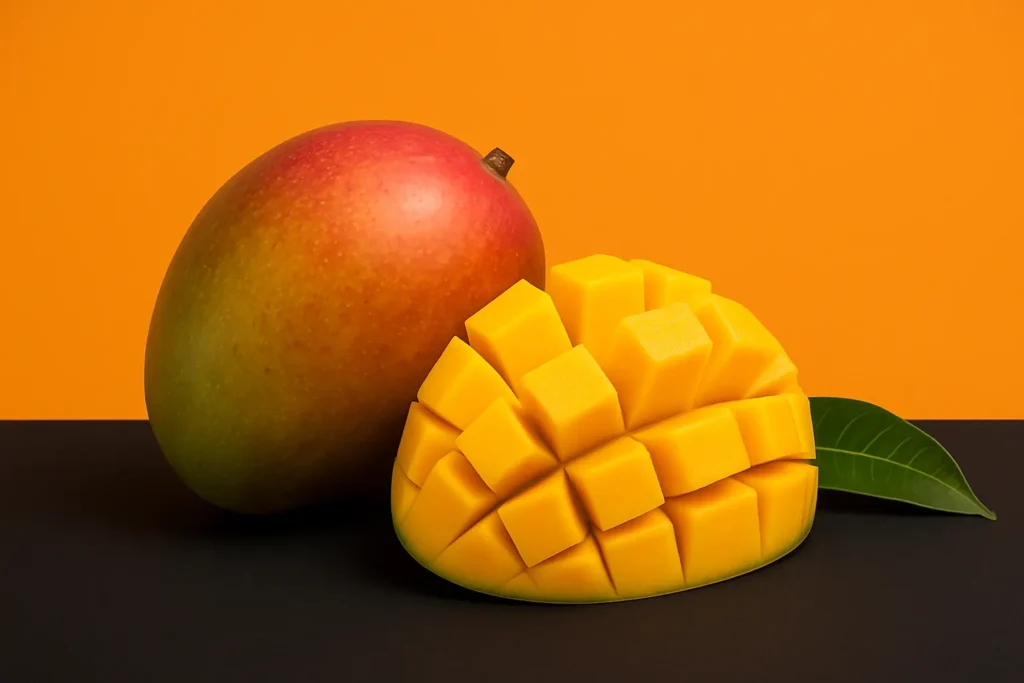Mango (Mangifera indica), often celebrated as the “King of Fruits,” is one of the most cherished tropical fruits worldwide. With its vibrant color, captivating aroma, and irresistible sweetness, it has earned a place not only as a seasonal delight but also as a nutritional powerhouse.
Native to South Asia, particularly India and Myanmar, mango belongs to the family Anacardiaceae and has a history of more than 4,000 years. Its unique blend of taste, cultural significance, and nutritional value has made it a global favorite. According to the Food and Agriculture Organization (FAO), India contributes nearly 40% of the world’s mango production, followed by China, Thailand, and Indonesia.
Origin and Historical Journey of Mango
- Ancient Roots – Mango is believed to have originated in the Himalayan foothills more than 4,000 years ago.
- Cultural Symbolism – In Indian traditions, mango leaves are considered sacred and are used in weddings, pujas, and festive decorations.
- Global Spread – During the 16th century, Portuguese traders introduced mango seeds to Africa, Brazil, and other tropical regions, expanding its cultivation worldwide.
Thus, mango transitioned from being a regional treasure to becoming a truly global fruit.
Popular Varieties of Mango
Mangoes exist in hundreds of varieties, each with its own unique flavor, texture, and aroma. Some world-famous varieties include:
- Alphonso (India): Known as the “King of Mangoes” for its sweetness and saffron-like aroma.
- Dasheri (India): Fiberless, sweet, and widely grown in Uttar Pradesh.
- Kesar (India): Famous for its bright orange pulp and rich flavor.
- Haden (USA): A commercial Florida variety with striking red-yellow skin.
- Ataulfo (Mexico): Small, golden mangoes with buttery texture.
- Tommy Atkins (Brazil/USA): Popular for its long shelf life and wide availability.
Nutritional Value of Mango
Mango is not just about taste—it is packed with essential nutrients that make it a superfruit.
Nutritional Profile (per 100g of ripe mango, USDA data):
- Calories: 60 kcal
- Carbohydrates: 15 g
- Sugars: 14 g
- Fiber: 1.6 g
- Protein: 0.8 g
- Fat: 0.4 g
- Vitamin C: 36 mg (60% DV)
- Vitamin A: 108 µg (12% DV)
- Potassium: 168 mg
- Magnesium: 10 mg
This nutrient-rich composition makes mango beneficial for immunity, digestion, heart health, and skin wellness.
Health Benefits of Mango
- Boosts Immunity – Loaded with Vitamin C, Vitamin A, and antioxidants, mango strengthens immunity and protects against infections.
- Improves Digestion – Enzymes like amylases and dietary fiber help improve gut health and prevent constipation.
- Supports Eye Health – Rich in beta-carotene and Vitamin A, mango helps maintain healthy vision.
- Enhances Skin & Hair – Vitamin C and antioxidants boost collagen production, reduce acne, and promote youthful skin.
- Good for Heart Health – Potassium and magnesium regulate blood pressure, while polyphenols lower bad cholesterol.
- Cancer-Preventive Properties – Research from Texas A&M University highlights the anti-inflammatory and anticancer potential of mangiferin, a mango polyphenol.
- Weight Management – Low in calories and high in fiber, mango keeps you full longer, helping control overeating.
Culinary Uses of Mango
Mango’s versatility makes it a favorite across cuisines:
- Fresh fruit – Enjoyed as slices, cubes, or in fruit salads.
- Juices & Smoothies – A refreshing summer drink.
- Pickles & Chutneys – Raw mango forms the base of tangy condiments in Indian cuisine.
- Desserts – Used in ice cream, puddings, cakes, and custards.
- Savory Dishes – Adds flavor to curries, salsas, and salads.
- Dried Mango – Popular as a convenient snack with a long shelf life.
Mango in Traditional Medicine
In Ayurveda and Unani systems, mango holds medicinal importance:
- Mango leaves – Used in managing diabetes.
- Raw mango – Helps prevent heat strokes in summer.
- Mango fruit – Acts as a natural energy booster.
- Mango kernel oil – Used in skincare for hydration and healing.
Global and Economic Importance of Mango
- India – The world’s largest producer, yielding nearly 20 million tonnes annually.
- Global Trade – Mango exports generate billions in revenue, with the USA, Middle East, and Europe being major importers.
- Employment – Mango farming provides livelihood to millions of farmers worldwide.
- Processed Industry – Products like pulp, nectar, juices, and dried mango slices form a significant part of the food-processing market.
Environmental and Cultivation Aspects
Mango trees are evergreen and can live for over 100 years. They thrive in tropical and subtropical climates with warm temperatures and a dry season for flowering.
- Soil: Well-drained loamy soil is ideal.
- Propagation: Grafting ensures the preservation of superior varieties.
- Harvest Season: In India, mango season ranges from March to August.
With the rising demand for organic produce, sustainable cultivation practices such as reduced pesticide use and eco-friendly farming methods are gaining momentum.
Fun Facts About Mango
- Mango is the national fruit of India, Pakistan, and the Philippines.
- India grows more than 1,000 different varieties of mangoes.
- The word “mango” comes from the Tamil word mangkay.
- A single mango tree can produce fruit for 40 years or more.
FAQs About Mango
1. Is mango safe for diabetics?
Yes, but portion control is necessary. One or two slices are safe when balanced with a healthy diet.
2. Can mango cause allergies?
Some people are allergic to urushiol in mango skin. Such individuals should avoid direct contact with the peel.
3. Which is the best mango variety?
Alphonso mango from India is considered the world’s best for its sweetness and aroma.
4. How many mangoes can I eat daily?
1–2 medium mangoes are generally healthy, but overconsumption may raise sugar levels.
5. What is the mango season in India?
Mango season runs from March to August, depending on region and variety.
Conclusion
Mango, rightly called the King of Fruits, is more than just a fruit—it is a symbol of tradition, wellness, and joy. From enhancing immunity to enriching cultural heritage, from powering global trade to delighting taste buds in countless recipes, mango continues to reign supreme.
In today’s health-conscious world, mango proves that taste and nutrition can go hand in hand. Whether relished fresh, blended into a smoothie, or used in gourmet dishes, mango remains a timeless celebration of flavor and life.
Read our beautiful blog on Watermelon: Nutrition, Health Benefits, Varieties & Uses
https://newsarmour.com/watermelon-nutrition-health-benefits-uses/






